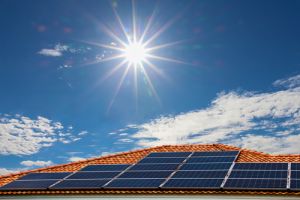From Coolangatta to Cairns and Toowoomba to Mt Isa, Queensland is a hotbed for sunshine, which explains why solar installations are through the roof right now. While there’s little debate over the benefits of solar power, it makes a lot of sense for those up north to want to see a return on their investment as quickly as possible, and that’s where a higher feed-in tariff (FiT) can help.
On this page:
- Which provider has the best solar feed-in tariff in QLD?
- Best solar feed-in tariffs in QLD
- Origin Energy feed-in tariffs QLD
- Which is the best solar energy provider?
- Are there any plans tailored to solar customers?
- Are feed-in tariffs the only factor I should consider?
- What is my current solar feed-in tariff?
- Is there a minimum feed-in tariff QLD?
- What about solar in regional QLD?
- How to maximise your solar investment in QLD?
Advertisement
Which provider has the best solar feed-in tariff in QLD?
Origin has the best solar feed-in tariff in Queensland at the time of publishing, with a generous 20 cents per kilowatt hour (kWh) on offer to eligible customers. The next best FiT rates come from AGL with 15c/kWh and EnergyAustralia with 12c/kWh. We list FiT rates from all energy providers currently operating in south-east Queensland a little further down.
Compare QLD Solar Plans
Here are some of the cheapest solar-specific deals from the retailers on our database. These are products from referral partners†. These costs are based on the Energex network in Brisbane but prices will vary depending on your circumstances. We show one product per retailer, listed in order of lowest price first. Annual price estimates assume general energy usage of 4613kWh/year for a residential customer on a single rate tariff. Price estimates exclude solar feed-in tariff credits. Our database may not cover all deals in your area, and please check retailer websites for up to date information.
Best Solar Feed-In Tariffs in QLD
In the table below, you’ll find a list of minimum and maximum solar feed-in tariffs available from retailers. Some of these companies do not operate in all areas of QLD, while some FiTs may only be available when certain conditions are satisfied. Please check each provider’s website for further details.
Many energy providers have currently switched off their market offer plans to new customers. We will do our best to keep the details on this page up to date as new information becomes available. Please treat information below as historical only, and check solar plan details/availability directly with energy providers.
← Mobile/tablet users, scroll sideways to view full table →
| Retailer | Minimum Feed-in Tariff (kWh) | Maximum Feed-in Tariff (kWh) |
|---|---|---|
| AGL | 5c | 15c (for first 10kWh/day, 5c/kWh thereafter) |
| Alinta Energy | 8c | 8c |
| Amber | 0c | 2.73c (estimated based on wholesale prices) |
| Ampol Energy | 5c | 5c |
| CovaU Energy | 5.5c | 5.5c |
| Diamond Energy | 0c | 5.2c |
| Discover Energy | TBC | TBC |
| Dodo | 5c | 5c |
| Electricity in a Box | TBC | TBC |
| EnergyAustralia | 6.6c | 12c (first 15kWh/day, 6.6c thereafter) |
| Energy Locals | 6c | 10.7c (for the first 10kWh/day, 6c thereafter) |
| Future X Power | TBC | TBC |
| GEE Energy | TBC | TBC |
| GloBird Energy | 1c | 11c (for the first 8kWh/day, 4c thereafter) |
| Glow Power | TBC | TBC |
| Kogan Energy | 0c | 5c |
| LPE | TBC | TBC |
| Momentum Energy | 0c | 4.5c |
| Nectr | 0c | 0c |
| Origin Energy | 5c | 20c (must purchase solar system through Origin that’s under 7kW) |
| OVO Energy | 0c | 8c |
| Powershop | 0c | 5c |
| Radian Energy | TBC | TBC |
| ReAmped Energy | TBC | TBC |
| Red Energy | 1c | 8c |
| Simply Energy | 5.5c | 7c |
| Smart Energy | TBC | TBC |
| Sumo | 3c | 4c |
| Tango Energy | 0c | 0c |
| 1st Energy | 6c | 6c |
Feed-in tariffs are for residential customers on a single rate tariff in Brisbane on the Energex network. Accurate as of February 2024.
Origin Energy Feed-in Tariffs QLD
One of the leading solar retailers is Origin in QLD, but to earn its maximum feed-in tariff of 20c/kWh, you need to get your solar panels installed with Origin and have a system under 7kW. So that’s no use if you already have a system and are just looking for the best rate going. In this case, you’ll have to settle for a still very reasonable 12c/kWh. See each plan option below.
Which is the best solar energy provider?
Red Energy was rated Australia’s best solar energy provider in our annual customer satisfaction ratings in 2023. An Australian-owned company, Red Energy took out a handful of five-star ratings, including customer service, focus on environmental sustainability and overall satisfaction. Red Energy is known for its partnership with Qantas where customers can earn Frequent Flyer points by paying their bills. It has one specific solar plan in the state – Red Solar Saver – which offers a 8c/kWh feed-in tariff. See the plans below.
Here are Red Energy’s plans on our database for SEQ. These costs are based on the Energex network in Brisbane but prices may vary depending on your circumstances. This comparison assumes general energy usage of 4613kWh/year for a residential customer on a single rate tariff. Please use our comparison tool for a specific comparison in your area. Our database may not cover all deals in your area. As always, check all details of any plan directly with the retailer before making a purchase decision.
Are there any plans tailored to solar customers?
Yes, some solar-specific products are on offer in QLD, however these deals are few and far between. Most larger companies, such as AGL and Origin, will generally have solar-specific plans available, but it normally requires certain conditions to be met, such as purchasing solar panels through the energy retailer. It’s a good idea to check the power provider’s website for terms and conditions.
Are feed-in tariffs the only factor I should consider?

While a high feed-in tariff can make a world of difference to overall energy costs, it may be suffering at the hands of expensive base rates. The two main costs to look out for are electricity usage rates and supply charges. These rates are billed to customers for the amount of electricity the household uses, along with a fixed daily cost of supplying power to their property via the grid.
Depending on how much electricity a solar system can export, it may be worth calculating which features of an energy plan are best-suited to your needs. For example, if you have a smaller solar system that doesn’t produce much excess electricity to be fed back into the grid, then you may be better off with lower base rates, as opposed to a higher feed-in tariff. On the other hand, if your solar panels export a lot of electricity, then a higher FiT could justify paying increased usage and supply rates. At the end of the day, it’s all about balancing out what works for your circumstances and budget.
What is my current solar feed-in tariff?
If you don’t know what your current feed-in tariff rate is, it should be located on your energy bill. Alternatively, you will find your FiT listed in the relevant energy fact sheet which can be found on your energy retailer’s website. Some power providers are sneakier than others, and may hide this information though it is generally situated at the bottom of the company’s homepage. All retailers must provide fact sheet documents that outline each plan’s rates, fees, charges, along with other important product details.
Is there a minimum feed-in tariff in QLD?

In south-east Queensland, there is no set minimum solar feed-in tariff that energy retailers have to adhere to. This is why shopping around for a plan with a good FiT is important as power companies will try to compete for your business by offering a more competitive FiT. Don’t forget to check directly with your energy retailer to see if there are promotions or solar-specific deals available, which may not be publicly advertised.
What about solar in regional QLD?
Unlike Queenslanders who live in the south-east on the Energex network, regional QLD customers on the Ergon Energy network have a minimum feed-in tariff rate of 13.441c/kWh. These rates are set by the Queensland Competition Authority (QCA), a governing body that also monitors retailer’s FiT rates in SEQ.
How to maximise your solar investment in QLD
Maximising your solar investment will come down to choosing an energy provider that offers a good feed-in tariff that best suits your needs. Remember, not all plans are equal, which means it does take some research to find a good deal. Just be sure to scan over the electricity rates of a plan, as well as any other value-add incentives, like discounts, bill credits and rewards programs. With more than 20 retailers across SEQ, there has never been a better time to compare your options.
Image credits: Jen Watson/Shutterstock.com, BOONJAEM/Shutterstock.com




Share this article